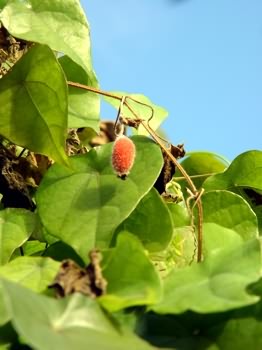Relatives
Thladiantha dubia Bunge - Thladiantha doubtful
Regular position.
Family: Cucurbitaceae Juss.; Sort: Thladiantha BungeMorphology and biology.
This is a perennial plant. Stalks reach 0.5-1.5 m in height, are covered by squarrose hairs, climbing with the help of hairy simple short tendrils. Leaves are 5-10 cm long, 4-9 cm wide, are wide, ovate, heart shaped and pointed at the top, densely haired from both sides. The base of the leaves has a deep lyrate dredging. Edge of a leaf plate is denticulate. Venues and petiole pubescence is rigid and setifolius. Short tendrils are thin, rigid-haired and simple. Flowers are single, the nimbus is yellow. Peduncles of stamen flowers are thin, 1-3 cm long, are long and soft-haired; the receptacle is short, has wheel form, fluffy, 7-8 mm wide; sepals are linear and lanceolate, turned back, 12-13 mm long; petals are lengthened, ovate, sharp, short haired, 2.5 cm in long. Peduncles of pistillate flowers are thick, 0.5-1.5 cm long, with short staminodes, oblong fluffy gynaecium, a naked column and 3 stigmas. Fruits are oblong-ovate, with 10 longitudinal grooves, green or red, pubescent, 4-5 cm long, 5 cm wide. Seeds are obovate, narrow at the base, smooth, 4-4.5 mm long, 2.5-3 mm wide, flattened. Blossoms from June until September; fructifies starting in July.Distribution.
The general (common) distribution includes: northeast areas of China. In the territory of the former USSR: the European part - the central and southern areas, in the north it reaches breadth of Tver and Nizhni Novgorod; the Far East: edge Ussurijsky (on the river Suchanu).Ecology.
Coastal meadows, sandy sea coasts, weed in gardens. It also grows in kitchen gardens and near habitation.Use and economic value.
It is used as an ornamental plant, thus easily can turn wild and becomes adventive plant. It is used in crossings with pumpkin, cucumber and melon.Reference citations:
Cherepanov S.K. 1995. Plantae Vasculares Rossicae et Civitatum Collimitanearum (in limics USSR olim)[List of Vascular Plants of Russia]. St. Petersburg: Mir I Semia. 990 pp. (In Russian)Gubanov I.A., Kiseleva K.V., Novikov B.S., Tihomirov V.N. 2003. Illustrated Manual of the Middle Russia Plants. V. 2. Moscow. 39 p.
Kharkevitch S.S., ed. 1987. Vascular plants of the Soviet Far East. V. 3. Leningrad: Nauka. 132 p. (In Russian)
Shishkin, B.K. & E.G. Bobrov, ed. 1957. Flora USSR. V. 24. Moscow-Leningrad: Publishing House of Acad. Science. 95-97 p. (In Russian)
Tsvelev N.N. 2000. Manual of the vascular plants of Russia (Leningrad, Pskov and Novgorod district). St. Petersburg: Publishing House of SPHFA. 781 p. (In Russian)


